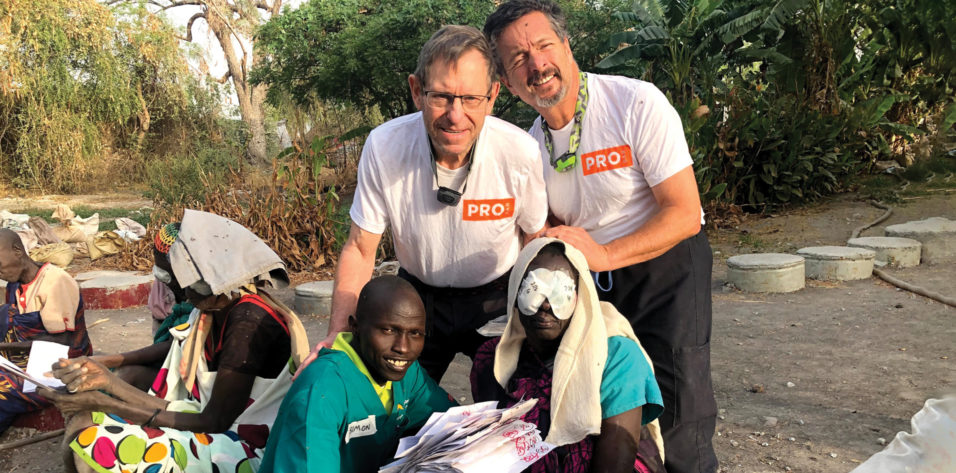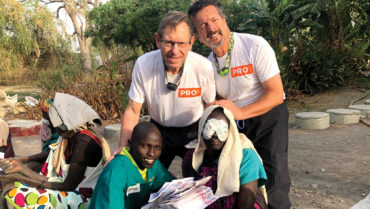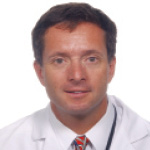
Many people refer to the great work being done by surgeons who travel and take the time to treat patients in the developing world as mission work. I, however, do not like that term—although it is my mission, I prefer to think of this rewarding experience as development work. It’s not the several thousand surgeries that I’ve performed in the developing world of which I am most proud.; it’s how I’ve helped to improve the quality of eye care and patient access to it in some of the poorer places in the world and the training I’ve provided to local surgeons to create a lasting impact on those communities.
Development work focuses on training and empowering the local people. Rather than perform 300 cataract surgeries in a week in Ethiopia or wherever I am, I teach two local trainees, one trainee from the United States, and as many experienced local doctors as possible to perform the procedures themselves.
THE EARLY DAYS OF THE HIMALAYAN CATARACT PROJECT
According to the World Health Organization’s 2019 World Report on Vision, individuals living in low-income regions, underserved populations, and rural communities are disproportionately affected by vision problems.1 In these areas, the causes of blindness are usually avoidable or treatable, but the solutions simply are not available.
For more than 27 years, I have made it my mission through the Himalayan Cataract Project (HCP) to help as many people who are living with needless blindness as possible. The aim of HCP is twofold: to care for the blind and to establish a sustainable eye care infrastructure by empowering local doctors to provide ophthalmic care through skills transfer and education.
This work started in Nepal because of a connection I had to the country from my residency days. Efforts focused on reaching patients where they lived and building a robust system for training Nepalese eye care providers. I worked closely with Sanduk Ruit, MD (Figure 1), who introduced me to some great young ophthalmologists in the Himalayan region who needed mentoring. HCP expanded slowly, first helping some of the young ophthalmologists with their specialty training and then developing a full training program in Nepal.

Figure 1. Drs. Tabin (left) and Crandall (right) with Sanduk Ruit, MD (center).
After spending a year in Nepal, I was fortunate to join forces with economist Jeffrey D. Sachs. He contracted with HCP to conduct a survey of the economic and human costs of blindness in some of the poorest communities in the world for the United Nations’ Millennium Villages Project. This project is based on a concept similar to HCP’s—empowering villagers to transform health care in underserved areas—and participants work with governments and other committed stakeholders to provide affordable, science-based solutions to end extreme poverty. By investing in health, food production, education, access to clean water, and essential infrastructure, community-led interventions seek to improve conditions for the world’s most destitute communities. Most of these communities currently exist on less than $1 per person per day.
HCP has helped develop efficient means of restoring sight to individuals in disadvantaged communities. The first Millennium Villages Project eye care intervention took place in Bonsaaso, a village in the northern Ashanti region of Ghana, in July 2007.
NEW OPPORTUNITIES
In 2006, Randall J. Olson, MD, brought me to the University of Utah, where I was able to devote even more time and energy to development work through HCP. One of my big incentives for moving to Utah was the chance to work with the late Alan S. Crandall, MD (Figure 2), the founder and senior medical director of the John A. Moran Eye Center Global Outreach Division. Alan spent time teaching trainees and local ophthalmologists in various countries, including Ghana, Ethiopia, South Sudan, Nepal, India, China, Guatemala, Tonga, Haiti, Micronesia, and Cuba (Figure at outset and Figures 3 and 4). He also provided regular services on the Navajo Nation (see “Global Outreach in the Era of COVID-19”).

Figure 2. Drs. Tabin (left) and Crandall (right) at one of the ASCRS’ annual meetings.
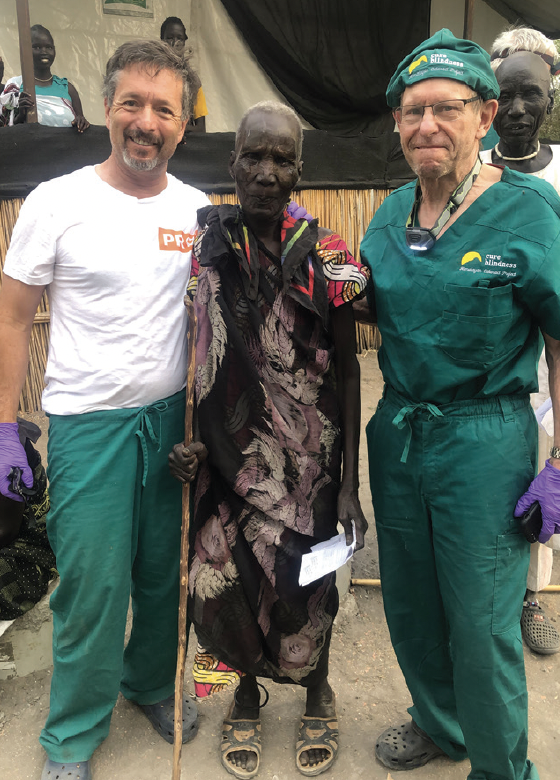
Figure 3. Drs. Tabin (left) and Crandall (right) with a patient in South Sudan.
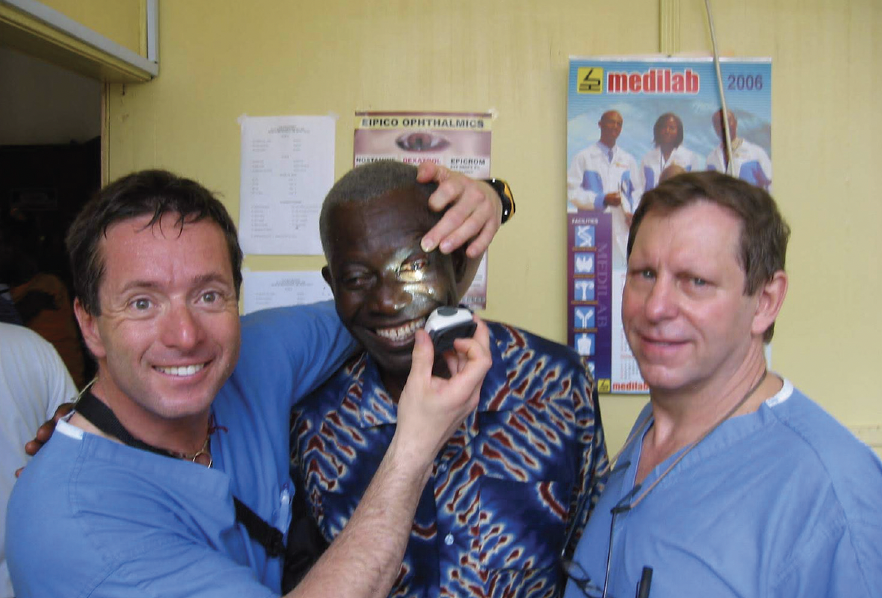
Figure 4. Drs. Tabin (left) and Crandall (right) with a patient in Ghana.
Other members of HCP and I worked alongside Alan to bring the same system of training and development that was successful in the Himalayan region to countries in South Africa. During our first collaboration, we helped train some of the talented young ophthalmologists in Ghana.
ADVICE FOR GETTING STARTED
If you are interested in getting involved in development work, my best piece of advice is to think about where you want to go and find ways to cultivate relationships with individuals from that region. Don’t travel to Guatemala one year and perform 250 cataract surgeries and then travel to Togo the next year and do 250 more. Pick one place that you will go back to year after year. Develop partnerships with the local doctors who can really benefit from your skills and aim to create sustained change in that community. Find a young, local ophthalmologist with whom to partner to improve their ability to diagnose and treat patients. Teach that doctor new diagnostic methods and help upgrade the available biometry equipment and operating microscope. Bring this individual to the annual ASCRS and AAO meetings and act as the doctor’s international host.
Working one-on-one with an individual doctor with whom you connect can be a valuable experience for you both. One way of meeting surgeons from the developing world who would benefit from mentorship is to attend international meetings such as the World Ophthalmology Congress or a regional meeting such as that of the Asia-Pacific Ophthalmology Society. Volunteer for Project Orbis or Surgical Eye Expeditions International. If you have a love for a certain country, contact its national eye care organization to inquire about mentorship opportunities. You must take the initiative to develop a personal relationship with a local doctor.
LESSONS LEARNED
Beyond the joy I get from helping to create sustainable eye care infrastructure and empowering local doctors, I have learned many lessons through my work in the developing world. Traveling to a poor country and performing 300 surgeries in a week has taught me to think better on my feet in addition to improving my skillset. The diagnostic and surgical equipment I use at home often is unavailable, and it is sometimes necessary to use completely unfamiliar equipment. The key is to figure out in an instant how to best serve a patient with whatever is on hand.
Development work has also taught me how to stay calm in difficult situations and how to think more efficiently. I no longer feel intimidated by even the most challenging cases anymore, and that is a lesson learned through years of development work.
CONCLUSION
Training colleagues, treating patients, and helping to establish sustainable eye care in the developing world are both professionally and personally rewarding. Above all else, the focus of development work is on patients. I treat every individual as someone who can benefit from having their sight (and life) restored, and it is this truth that drives me onward.
1. World report on vision. World Health Organization. 2019. Accessed September 22, 2021. https://www.who.int/publications/i/item/9789241516570

